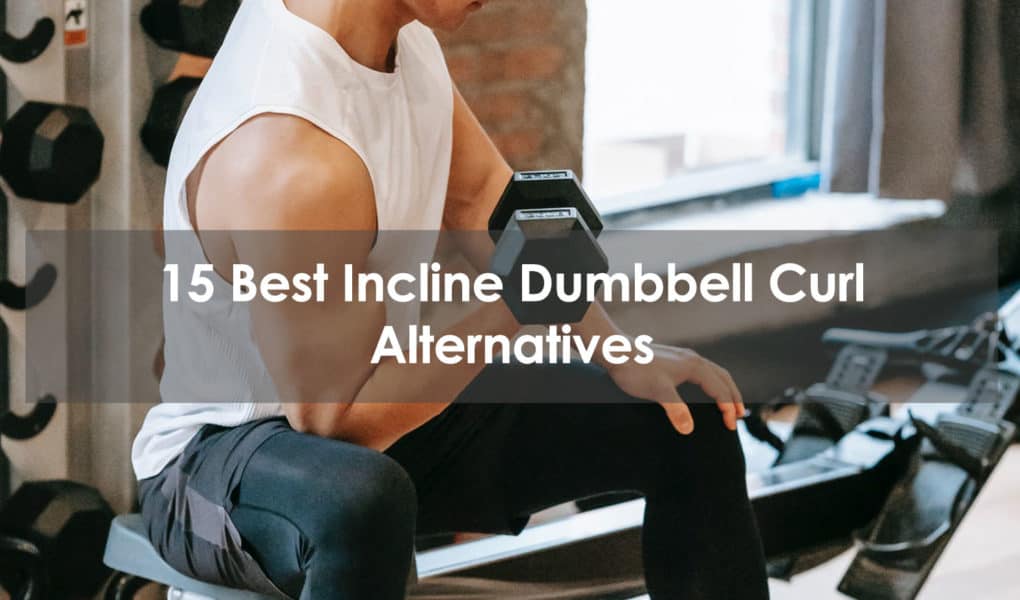The incline dumbbell curl is one of the most effective exercises for targeting your bicep muscles, as the inverted angle widens the range of motion and makes the bicep curls more challenging.
This exercise isolates your biceps brachii muscle, though it does also require support from your shoulders and abdominal muscles.
If the incline dumbbell curl isn’t an option for you, or you’re looking for some alternatives to target your biceps with, here are the best exercises you can perform instead.
1. Preacher curl
How to
- Sit at the preacher bench with your back straight, and lay your arms over the platform so that your triceps are resting on it.
- Take hold of the handles, or bar, with an underhand grip, then curl them toward your face, squeezing your biceps at the top of the movement.
- Lower back to the starting position and repeat for 10-12 reps.
Equipment used
- Preacher curl bench
Why it works
Like incline curls, the preacher curl puts a sharp focus on your biceps muscles. Plus, the platform provides support for your upper body, meaning you can lift heavier weights without a high risk of injury.
2. Dumbbell concentration curl
How to
- Sit on an incline bench laid flat, or a box or chair, with your feet flat on the ground and knees bent.
- Take a dumbbell in your right hand, between your feet, and place your elbow against your right inner thigh.
- Lean forward, and curl the weight up to shoulder level on your right side, then lower back down under control.
- Repeat for 8-10 reps on each arm.
Equipment used
- Bench/box/chair
- Dumbbell
Why it works
This is a move that’s been used for generations to build bigger biceps, and it’s clear to see why. Like preacher curls and incline curls, this exercise isolates your biceps and also prevents you from using momentum to lift the weight; it all has to come from muscle strength.
3. Prone incline curl
How to
- Set an incline bench to a 45-degree angle, then lay across it with your chest down, holding a dumbbell in either hand.
- With your back straight, allow your arms to drop down below you, with your palms facing forward. This is the starting position.
- Curl the weights up, just as you would with any other curl variation, then lower them back down under control.
- Repeat for 10-12 reps.
Equipment used
- Incline bench
- Dumbbells
Why it works
Your arms are moving through a very similar range of motion to the concentration curl, plus you’ve got the added benefit of your weight resting against the bench, meaning it can’t be used to move the weights. This means your biceps are doing all the work.
4. Chin ups
How to
- Stand under a pull-up bar and take hold of it with an underhand grip, your palms facing toward your face.
- With your feet off the floor, pull your torso upward using your arms until your chin rises just above the bar.
- Lower yourself back down and repeat for 8-10 reps.
Equipment used
- Pull-up bar
Why it works
Though this isn’t an isolated bicep exercise, your biceps muscles are doing a large bulk of the work to lift your body up and then lower it down under control. This is an effective move as it isn’t focusing on just one single muscle; it engages numerous arm muscles and some in your back.
5. Cable curl
How to
- Set the cable pulley to its lowest height, with the bar attachment on. Stand in front of it, then bend down and take hold of the bar with a supinated grip and stand to bring the bar to your waist.
- Starting with your arms straight, bend at the elbows to curl the bar up to your chest.
- Slowly lower the bar back down and repeat for 12-15 reps.
Equipment used
- Cable pulley machine
Why it works
Research has shown that this is one of the best exercises for bicep strength training, which is why it’s featured in so many workout routines. This variation on curl exercises promotes muscle growth as well, meaning it helps to get your biceps looking bigger and stronger.
6. Hammer curl
How to
- Hold a pair of dumbbells at your side with your palms facing each other.
- Bend at the elbows and curl the weights up, keeping your palms facing each other, until your elbow bends slightly beyond a 90-degree angle.
- Lower the weights back down to your sides and repeat for 10-12 reps.
Equipment used
- Dumbbells
Why it works
Of all the bicep curl alternatives available, this is one that not only targets your biceps but also improves your grip strength and wrist stability.
7. Overhead double cable curl
How to
- Set the cable pulley so that it is adjusted to your height, and you can stand with your arms outstretched to the side, holding the handles on both pulleys.
- Keep your core engaged and bend your elbows to curl the handles toward your head, bringing them as far as you can.
- Release back so your arms become outstretched again, then repeat for 12-15 reps.
Equipment used
- Cable pulley machine
Why it works
Your biceps are completely isolated in this movement, plus your front delts – which can be used in more traditional curls – aren’t activated here, meaning it really is just your biceps working.
8. Resistance band bicep curls
How to
- Slide a resistance band under your feet and take hold of it with either one hand or both.
- Bend at the elbows and curl the band up toward your chest.
- Release back down and repeat for 15-18 reps.
Equipment used
- Resistance band
Why it works
Simple to perform with minimal equipment, these curls are great for beginners and those looking to build up a base level of strength in their biceps.
9. Decline push-ups
How to
- Set up a box or a bench and adopt a high plank position in front of it, with your feet resting on the platform, on your toes. Your hands should be under your shoulders, arms straight.
- Bend at the elbows and lower your torso down toward the floor, then drive back up through your hands to return to the starting position.
- Repeat for 12-15 reps.
Equipment used
- Bench/box/chair
Why it works
By elevating your feet, you’re loading more of your weight forward. This makes the decline push-up one of the most surprisingly effective biceps exercises, as the fronts of your arms have to work harder to move your weight up and down.
10. Commandos
How to
- Adopt a high plank position with your hands under your shoulders, arms straight.
- Dropdown onto your right forearm, then your left as well.
- Place your right hand back on the ground and push up to straighten the arm. Do the same on the left side.
- Repeat the movement, but starting on the left side. Do this for time, alternating the side you begin with each time.
Equipment used
- None
Why it works
Though this isn’t necessarily a great move for building muscle, as you’re only moving your body weight, it still fires up your biceps, as well as many other muscles in your upper body. When performed at speed, it’s also an excellent cardio workout.
11. Bent over rows (reverse grip)
How to
- Hold a loaded barbell across your waist with an underhand grip. Pull your shoulders back and keep your spine straight.
- Lean forward, with a slight bend in your knees, and allow the bar to slide down your legs until it’s level with your knees.
- Pull the bar up into your torso, with your elbows bent, making sure to squeeze your biceps.
- Lower the bar back down and repeat for 10-12 reps.
Equipment used
- Barbell
Why it works
The change in grip position from a standard row means your biceps are activated during this movement, and work in conjunction with your lats to move the weight.
12. Inverted row (reverse grip)
How to
- Set an unloaded barbell onto a squat rack, or across two secure platforms where it won’t move. Ensure it’s at a height where you can hold onto it with extended arms without your back touching the floor.
- Lie under the bar with your upper chest in line with it, and take hold of the bar with an underhand grip, arms straight and body suspended off the floor. Your heels should be on the ground and your entire body should create a straight line.
- Pull your torso up to the bar by bending your arms, then slowly release yourself back down without touching the floor.
- Repeat for 12-15 reps.
Equipment used
- Barbell
Why it works
This move is very similar to the bent over row, except here you are lifting your body weight, rather than any external resistance. The move creates consistent muscle tension in your biceps, providing them with a solid workout.
13. Alternating dumbbell curls
How to
- Hold a pair of dumbbells by your sides, palms facing inward.
- Bend at your right elbow to curl the weight up toward your chest, rotating your palm outward so that it faces up.
- Lower the weight back down, rotating your palm back the other way so it’s facing inward again.
- Repeat on the left side and alternate arms with each rep. Perform 8-10 reps on each arm.
Equipment used
- Dumbbells
Why it works
Unlike other curls, here you have to promote the biceps, even more, to rotate the weight as you curl it up to your chest, plus you are isolating your arms one at a time.
14. EZ bar curl
How to
- Grip the EZ bar with an underhand grip, hands in line with your shoulders.
- Curl the bar up to your chest, then lower it back down.
- Repeat for 10-12 reps.
Equipment used
- EZ bar
Why it works
The form of the bar allows you to add more weight to it than with regular curls, plus it puts less stress on your forearms and joints.
15. Seated cable row
How to
- Sit at the cable row station with your feet flat against the platform and a slight bend in your knees. Ensure you have the v-bar attachment on the pulley.
- Hold the attachment with your palms facing inward and, keeping your spine straight, pull the bar toward your torso, bending your arms as you do so.
- Release back to the starting position and repeat for 10-12 reps.
Equipment used
- Cable row station
Why it works
Though this is predominantly a back exercise – more specifically, one that targets your lats – your biceps are also activated during the movement, especially with your palms facing each other.
Conclusion
The biceps are some of the most aesthetically prominent muscles on the body, which is why they’re focused on in so many workouts. The exercises above are excellent alternatives to the incline dumbbell curl. Some include specialist equipment while others can be performed with just your body weight.
Frequently Asked Questions
Are incline curls harder?
In theory, incline curls are slightly more difficult than regular curls as you are moving the weight through a wider range of motion, and there is slightly less stability in the arms as you are laying backward at an angle. This, of course, can change from person to person though.







